Related Research Articles

The RA-14 Loisirs was a French two-seat high-wing light touring aircraft designed by Roger Adam shortly after World War II.
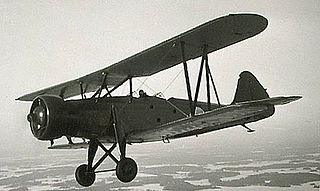
The VL Tuisku was a Finnish trainer aircraft designed in the 1930s. It was a two-seat, single-engined biplane with a welded steel framework, covered with fabric. 30 were produced for the Finnish Air Force and served from 1935 to 1949.

The Valmet PIK-23 Towmaster or Suhinu is a Finnish two-seater glider-towing/primary trainer aircraft built entirely out of composite materials in the early 1980s.

The Caudron C.600 Aiglon is a 1930s French two-seat monoplane sport/touring aircraft built by Caudron–Renault.

The Nord Aviation 3202 was a 1950s French military trainer aircraft designed and built by Nord Aviation to meet a French Army requirement for a two-seat basic trainer, as a replacement for the biplane Stampe SV.4. Altogether, 101 examples were built, with the first flying on 17 April 1957.
The Brochet MB.120 was a two-seat light aircraft developed in France in the 1950s.
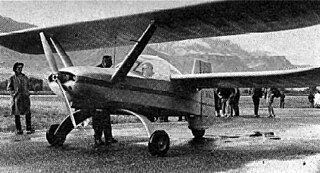
The Croses EC-6 Criquet ("Locust") is a 1960s French two-seat homebuilt aircraft designed by Emilien Croses.
The Cvjetkovic CA-61 Mini-Ace is a 1960s American homebuilt monoplane aircraft designed by Anton Cvjetkovic.

The Goodyear GA-2 Duck was a 1940s American three-seat light amphibious aircraft built by the Goodyear Aircraft Corporation. The design team included David Thurston, who later developed several other light seaplanes including the Colonial Skimmer, Lake Buccaneer, Thurston Teal and Seafire. Only 19 aircraft were built, and these were used only for testing and as demonstrators.

The Harlow PJC-2 was a 1930s American four-seat cabin monoplane, designed by Max Harlow.

The Muniz M-7 was a two-seat primary training biplane with tandem open cockpit and powered by a 130 hp (197 kW) de Havilland Gipsy Major engine. Designed by Lieutenant-Colonel Antonio Muniz, a serving officer in the Brazilian Air Force, as a primary trainer. It was first flown in October 1935 and a small production run was built for the air force by Companhia Nacional de Navegação Aérea.
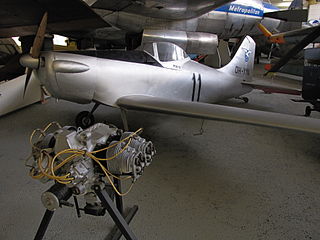
The PIK-11 Tumppu ("Mitten") was a single-seat, single-engine sport aircraft developed in Finland in the 1950s. It was a low-wing, cantilever monoplane of conventional design with an enclosed cockpit and fixed, tailwheel undercarriage. It was to be the first powered aircraft produced by Polyteknikkojen Ilmailukerho, with the objective being building an aircraft for club use that was cheap to build and easy to fly.

The Spencer Amphibian Air Car is an American light amphibious aircraft. The name was first used in 1940 for a prototype air vehicle that developed into the Republic Seabee. The name was later used by its designer Percival Spencer for a series of homebuilt amphibious aircraft roughly based on the Seabee design.

The Preceptor N3 Pup is a family of ultralight, tube-and-fabric, high-wing, homebuilt aircraft. Kits were produced and marketed by Preceptor Aircraft, of Rutherfordton, North Carolina. The company was operating on a limited basis, actively selling plans online, but seems to have gone out of business in 2016.

The Partenavia P.53 Aeroscooter was a 1950s Italian single-seat light aircraft fitted with a two-bladed rotor. It was designed by Luigi Pascale with Mario de Bernardi and built by Partenavia.
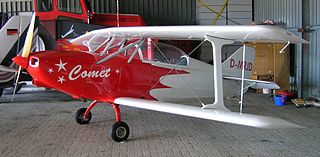
The B&F Fk12 Comet, also called the FK-Lightplanes FK12 Comet, is a single-engine, two-seat sports biplane designed in Germany. First flown in 1999, it was available as a kit or complete and ready-to-fly.

The Salvay-Stark Skyhopper I is a low-wing single-place homebuilt aircraft designed in 1944.
The de Bernardi M.d.B. 02 Aeroscooter is a two-seat light sport aircraft designed by Mario De Bernardi as a follow-on to the single-seat Partenavia P.53 Aeroscooter.

The Dittmar HD 153 Motor-Möwe was a West German light aircraft that was first flown in November 1953.
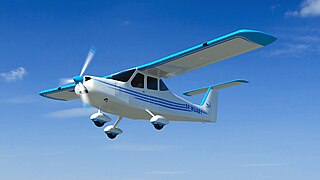
The Aero-Service Panda is a Polish ultralight, designed and produced by Aero-Service Jacek Skopiński of Warsaw. The aircraft is supplied complete and ready-to-fly.
References
- ↑ Frederick Thomas Jane; Charles Grey Grey; Leonard Bridgman; Leonard Howard-Flanders (1959). Jane's all the world's aircraft.
- ↑ D.Vincent Marrone
- ↑ Sport Aviation. Jan 1958.
{{cite journal}}: Missing or empty|title=(help) - ↑ D.Vincent Marrone
- ↑ "ASN Wikibase Occurrence # 40625" . Retrieved 14 April 2011.